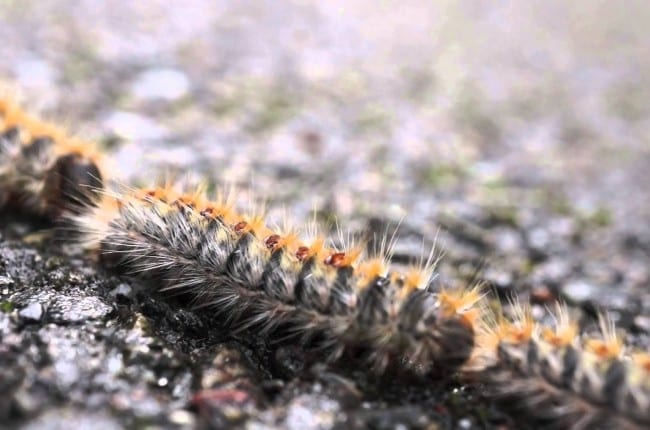 A LETHAL caterpillar capable of killing pets is back in Spain.
A LETHAL caterpillar capable of killing pets is back in Spain.
The Pine Processionary Caterpillar can pose a major risk to children and adults, causing dermatitis, eye damage and severe allergic reactions.
In pets, particularly dogs, they can cause breathing difficulties, vomiting and foaming at the mouth.
Pets showing such symptoms should be taken to the vet immediately.
The caterpillars, which come out in force in the spring, are covered with tiny barbed hairs that contain a protein called thaumetopoein.
Dogs are most at risk as they can pick up the hairs in their paws which they then lick when they become irritated, causing the poison from the hairs to spread to the mouth.
Amputations of the tongue or nose can be necessary to prevent the poison reaching the throat and causing suffocation.
Pine forests or areas with pine trees are the most at risk locations.
Councils may spray down municipal parks but they cannot always be relied upon.
Click here to read more News from The Olive Press.









Toxic caterpillars are a good example to study the flow of autonomous traffic.
If you happen to meet them in the forest try this:
(For simplicity I call the chain of caterpillars a ‘train’)
1. Undock the ‘train’ in the middle by using a stick carefully so as not to hurt the animal and not to contaminate yourself by poison. You will recognize that the front part stops immediately and is waiting for the ‘tail’.
Now you have two ‘trains’. Send one train into the opposite direction of the other train. After a while you will recognize, that one train will dock at the back of the other train and will follow the direction of the front part.
2. Undock the last ‘wagon’ of the train and move it two inches in front of the top of the train. The rest of the train will dock at the single wagon and follow it’s direction.
3. Split the train into three parts. You will soon recognize that all three parts are going to join again for a single train.
Your children will be thrilled.
How can you get rid of the caterpillers we have a lot of pine trees and the caterpillers are in abundance
Janet – You really can’t get rid of them. Chemicals contaminate everything including the one who applies it. There have been excellent studies on this epidemic in southern Canada and northwest USA. Advanced research has discovered that the pine trees’ genome has built into it an evolvd system. In any group of trees there will be one or a few – depending on the quantity you have – which will not succumb to the boring larva due to some kind of natural repellent.
Those without the genetic variant will succumb, but not necessarily all will die. Then what you are left with after trees die are the healthy genetic strain which reproduces healthy seedlings. Temperature, ie, global weather change is apparently responsible for the conditions as in most cases the moth/larvae won’t survive cold winters.
.
We had an attack 3 years ago. We did nothing as I did not want to risk the asthma lung problems, not contaminate the soil with these very harsh pesticides. The larvae absolutely destroyed the big tree, but – so far – haven’t spread to the 6. We will see. In any case there really isn’t anything to be done except wait for the end of the infestation, then cut down and expose of the tree, being mindful that the dangerous hair may float if you choose to burn it.
There was an upside: several varieties of woodpeckers and flickers moved in to enjoy the feast.
Janet – You really can’t get rid of them. Chemicals contaminate everything including the one who applies it. There have been excellent studies on this epidemic in southern Canada and northwest USA. Advanced research has discovered that the pine trees’ genome has built into it an evolved system. In any group of trees there will be one or a few – depending on the quantity you have – which will not succumb to the boring larva due to some kind of natural repellent.
Those without the genetic variant will succumb, but not necessarily all will die. Then what you are left with after trees die are the healthy genetic strain which reproduces healthy seedlings. Temperature, ie, global weather change is apparently responsible for the conditions as in most cases the moth/larvae won’t survive cold winters.
We had an attack 3 years ago. We did nothing as I did not want to risk the asthma lung problems, not contaminate the soil with these very harsh pesticides. The larvae absolutely destroyed the big tree, but – so far – haven’t spread to the 6. We will see. In any case there really isn’t anything to be done except wait for the end of the infestation, then cut down and expose of the tree, being mindful that the dangerous hair may float if you choose to burn it.
There was an upside: several varieties of woodpeckers and flickers moved in to enjoy the feast.
Silly game Wolfgang. Your children may well be poisoned by the air-borne hairy toxic spines.
People and pets have been felled metres away from these rascals.
Janet – You really can’t get rid of them. Chemicals contaminate everything including the one who applies it. There have been excellent studies on this epidemic in southern Canada and northwest USA. Advanced research has discovered that the pine trees’ genome has built into it an evolvd system. In any group of trees there will be one or a few – depending on the quantity you have – which will not succumb to the boring larva due to some kind of natural repellent.
Those without the genetic variant will succumb, but not necessarily all will die. Then what you are left with after trees die are the healthy genetic strain which reproduces healthy seedlings. Temperature, ie, global weather change is apparently responsible for the conditions as in most cases the moth/larvae won’t survive cold winters.
.
We had an attack 3 years ago. We did nothing as I did not want to risk the asthma lung problems, not contaminate the soil with these very harsh pesticides. The larvae absolutely destroyed the big tree, but – so far – haven’t spread to the 6. We will see. In any case there really isn’t anything to be done except wait for the end of the infestation, then cut down and expose of the tree, being mindful that the dangerous hair may float if you choose to burn it.
There was an upside: several varieties of woodpeckers and flickers moved in to enjoy the feast.
Stefanjo, no problem. Kids may watch from a distance.
Being a allergic adult I never have been poisoned by this game.
Kids tend to copy their parents. It’s called “being a good example”. Suppose you, with your in-built superpower, aren’t around the next time one of these “trains” chugs into sight?
Janet – You really can’t get rid of them. Pesticides would need contaminate everything. There are excellent studies in southern Canada and northwest USA. Research shows that the pine trees’ genome has built into it a long term survival system. In a group of trees there are one or a few – depending on the quantity – which larva won’t attack due to a natural repellent.
Those without the genetic variant will die. What you are left with are healthy genetic strain that produce good seedlings. Global weather change apparently is responsible for conditions as moth/larvae won’t survive cold winters.
We had an attack. I did not want to risk the asthma lung problems or contaminate soil. The larvae destroyed the big tree, but – so far – the attack hasn’t spread to the 6. We will see. There really isn’t anything to do except wait, cut down and despose of the tree, being mindful that hair may float if you to burn it.
Several varieties of woodpeckers and flickers moved in to enjoy the feast.
Research citation Diana Six, U of Montana: http://www.motherjones.com/environment/2015/03/bark-pine-beetles-climate-change-diana-six
Chas, interesting, on the map it looks like bark beetles are attacking trees mostly in states where Trump had won the US presidential elections, while the trees seem to be healthier in Hillary’s states. A result of or a prerequisite for their opposite mindset against climate change?